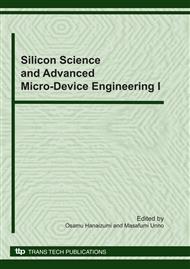p.51
p.57
p.63
p.67
p.71
p.78
p.84
p.92
p.100
Control of Methanol Crossover Using a Perforated Metal Sheet for DMFC Application
Abstract:
In this study, to control the methanol crossover occurring in a direct methanol fuel cell, DMFC, a perforated metal sheet of which the pore diameter and the porosity (open ratio) were regularly controlled was used in a passive DMFC, and the influence of the open ratio and the pore diameter on the power generation characteristics, and also on the methanol crossover of the passive DMFC were investigated on the basis of the power generation experiment at several different methanol concentrations. It was found that the pore diameter of the metal sheet did not affect the power generation characteristics and the methanol crossover in this experiment. On the other hand, the open ratio of the metal sheet significantly influenced the power generation characteristics, and the methanol transport was increased by decreasing open ratio of the metal sheets. It was found that a high concentration of methanol can be used at low open ratios below 3%. However, when the open ratio was higher than 3%, it hardly affected the current density and the mass transport. This means that the open ratio is not an important factor for the methanol transport or the electrode reaction in the range over 3%.
Info:
Periodical:
Pages:
71-77
Citation:
Online since:
December 2010
Keywords:
Price:
Сopyright:
© 2011 Trans Tech Publications Ltd. All Rights Reserved
Share:
Citation:


